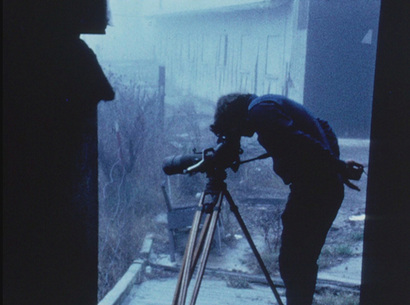Five Artists: BillBobBillBillBob (1971)

Though often described as an experimental filmmaker, Gunvor Nelson (My Name Is Oona) has stated in interviews that she prefers to categorize her work as "personal cinema." That designation definitely rings true for Five Artists: BillBobBillBillBob, a 70 minute feature she co-directed with Dorothy Wiley (Cabbage), for Nelson and Wiley were married to two of the artists profiled. That all five of the San Francisco-based artists and their families were close friends whose careers intertwined contributes to the rare intimacy of the portraits. In order of their appearance, those profiled are painter/sculptor/filmmaker William T. Wiley, filmmaker Robert Nelson, painter William George Allan, painter/sculptor William Geis, and painter/sculptor Robert H. Hudson.
A 16mm cinematic collage, Five Artists: BillBobBillBillBob alternates color and black and white footage of the artists at work in their studios, at home with their families, and, in several cases, in classrooms with their students. Its non-synchronized audio track consists of recollections and observations about each subject from friends, family members, and the artists themselves.
Among the revelations are their shared kinship with the natural world (dogs, snakes, fish, and other animals appear onscreen) and the desire to instill in their children an appreciation for life in its awe-inspiring complexities. A viewer may also discern the determination of spirit required to create art that occasionally is in itself not so serious.
Scenes featuring the painstaking and exacting creation of art are intercut with more commonplace human activities: picnics, parties, eating, and drinking. Bill Allan's profile explores his love of fishing, a passion that manifests itself in his art. In a later segment, William Geiss is heard recounting a bizarre science fiction scenario he's writing. A similar surreal perspective is evident in his otherworldly sculptures and paintings.
Of the artists profiled, the one most likely familiar to cinema aficionados will be the late Robert Nelson, whose satirical short films Oh Dem Watermelons (1965) and Hot Leatherette (1967) are often shown in film classes as examples of the New American Cinema movement. Here, Nelson is shown making, with William Wiley, The Great Blondino (1967), an absurdist classic inspired by 19th century French acrobat Charles Blondin. Nelson's portrait may be of the most interest to film buffs, but the others are no less compelling in demonstrating that, whatever the medium involved, the artists approach the act of creation seemingly from necessity.
Five Artists: BillBobBillBillBob concludes with brief clips of each man followed by scrapbook photographs from their adolescence, childhood, and infancy. One toddler's stern gaze elicited audience laughter during the showing I attended, but it highlights one of the film's key observations: how these five men find meaning in their relationship with others and how they create art are both part of the same impulse, an urge that may well be ordained by life.
Though not for sale as home video, Five Artists: BillBobBillBillBob is available for rental in 16mm from its distributor, Canyon Cinema (www.canyoncinema.com).
A 16mm cinematic collage, Five Artists: BillBobBillBillBob alternates color and black and white footage of the artists at work in their studios, at home with their families, and, in several cases, in classrooms with their students. Its non-synchronized audio track consists of recollections and observations about each subject from friends, family members, and the artists themselves.
Among the revelations are their shared kinship with the natural world (dogs, snakes, fish, and other animals appear onscreen) and the desire to instill in their children an appreciation for life in its awe-inspiring complexities. A viewer may also discern the determination of spirit required to create art that occasionally is in itself not so serious.
Scenes featuring the painstaking and exacting creation of art are intercut with more commonplace human activities: picnics, parties, eating, and drinking. Bill Allan's profile explores his love of fishing, a passion that manifests itself in his art. In a later segment, William Geiss is heard recounting a bizarre science fiction scenario he's writing. A similar surreal perspective is evident in his otherworldly sculptures and paintings.
Of the artists profiled, the one most likely familiar to cinema aficionados will be the late Robert Nelson, whose satirical short films Oh Dem Watermelons (1965) and Hot Leatherette (1967) are often shown in film classes as examples of the New American Cinema movement. Here, Nelson is shown making, with William Wiley, The Great Blondino (1967), an absurdist classic inspired by 19th century French acrobat Charles Blondin. Nelson's portrait may be of the most interest to film buffs, but the others are no less compelling in demonstrating that, whatever the medium involved, the artists approach the act of creation seemingly from necessity.
Five Artists: BillBobBillBillBob concludes with brief clips of each man followed by scrapbook photographs from their adolescence, childhood, and infancy. One toddler's stern gaze elicited audience laughter during the showing I attended, but it highlights one of the film's key observations: how these five men find meaning in their relationship with others and how they create art are both part of the same impulse, an urge that may well be ordained by life.
Though not for sale as home video, Five Artists: BillBobBillBillBob is available for rental in 16mm from its distributor, Canyon Cinema (www.canyoncinema.com).